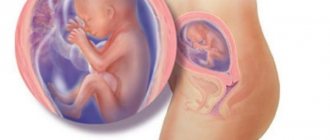Progesterone (from Latin “pregnancy hormone”) is a female sex hormone that prepares a woman for pregnancy. In the female body, progesterone is produced in the ovaries, placenta and adrenal glands. Its main function is to ensure pregnancy and regulate menstruation.
In the male body, progesterone is produced significantly less. It is synthesized by testicular and adrenal tissues. Men produce testosterone and a number of other important hormones based on progesterone, but its role is less significant than in women.
To test for progesterone, blood is taken from a vein. In the laboratory, blood serum is purified from blood cells and examined using the immunochemical method. Modern analyzers allow you to get analysis results in a few hours. On average, the waiting period is 1 day.
The role of progesterone in a woman’s body
Progesterone is a steroid hormone. In the female body, this biologically active substance is responsible for reproduction processes and affects processes occurring in many organs.
Progesterone deficiency in a woman can lead to serious consequences:
- before pregnancy - infertility due to the fact that the endometrium of the uterus is not ready for the attachment of a fertilized egg;
- during pregnancy - spontaneous termination of pregnancy - miscarriage.
High progesterone in women is also accompanied by unpleasant symptoms:
- migraine;
- visual impairment;
- acne;
- chronic fatigue;
- intermenstrual bleeding.
Features of progesterone production
1. Progesterone in non-pregnant women is produced by the corpus luteum and, to a small extent, by the adrenal glands. The corpus luteum is a temporary endocrine gland located in the ovary. Its name is explained by its color, which is due to a large amount of yellow pigment - lutein. The activity of the corpus luteum, and therefore the synthesis of the hormone, is regulated by the immune system, ovarian and pituitary hormones. The development cycle of the corpus luteum consists of 4 stages:
- Proliferation . Every month, a follicle containing an egg matures in one of the ovaries. During ovulation, the follicle bursts and the egg is released into the abdominal cavity. After this, the walls of the follicle gather in folds and it “closes.” Hemorrhage occurs into the cavity, which provokes active division of granulosa cells lining the walls of the follicle.
- Vascularization . A large number of blood capillaries are formed in the walls of the follicle. Thanks to their intensive work, the corpus luteum of the ovary has the most intense blood flow of all organs of the female body.
- Heyday _ The corpus luteum increases significantly in size to 2.3 cm and protrudes above the surface of the ovary. It increases progesterone synthesis 30 times compared to the initial stage of the menstrual cycle. This phase should last about 12 days. If it decreases, then they speak of corpus luteum deficiency and the woman cannot become pregnant.
- Fading . If pregnancy does not occur, the cells decrease, and dystrophic changes occur in the corpus luteum. It is gradually replaced by scar tissue, turning into a white body. This is accompanied by a decrease in the concentration of progesterone in the blood.
2. Progesterone during pregnancy . When pregnancy occurs, the corpus luteum continues to synthesize the hormone for another 12 weeks, almost the entire first trimester. Its work is stimulated by the membranes of the embryo (chorion) through human chorionic gonadotropin. In the second trimester, the placenta takes over the function of producing progesterone.
The level of the hormone increases steadily from the 9th to the 32nd week of pregnancy. During this time, the concentration of progesterone in the blood increases 15 times compared to the body of a non-pregnant woman. This hormone controls not only the condition of the uterus, but also the entire metabolism of a pregnant woman. Thanks to progesterone, a woman absorbs the maximum amount of nutrients from foods, which is accompanied by the deposition of adipose tissue.
The effect of progesterone on a woman’s body
- On the mucous membrane of the uterus. During the first 14 days of the menstrual cycle ( proliferative phase ), the uterus is affected by estrogens produced by the growing follicle. They stimulate active division of endometrial cells. After ovulation, the follicle turns into the corpus luteum and produces progesterone. The secretion phase begins , the duration of which is also about 14 days (an increase or decrease of more than 2 days is pathology). During this phase, progesterone has a direct effect on the endometrium, causing changes that create a favorable environment for the attachment of a fertilized egg and the development of the embryo. Secretion of the uterine glands, their secretion of mucous secretion containing glycogen and polysaccharides. The ducts of the glands twist and expand, which allows them to increase their area.
- Spiral twisting of blood vessels. The hormone makes them tortuous and full-blooded, which is important for the blood circulation of the unborn fetus.
- The stroma (loose connective tissue that fills the gaps between the endometrial glands) becomes swollen and accumulates fluid and nutrients.
A decrease in progesterone concentration at the end of the cycle causes: arterial spasm, deterioration of cell nutrition and melting of endometrial connective fibers. These changes make it easier to shed the mucous membrane during menstruation.
- During pregnancy. Progesterone prepares the body for childbirth and stimulates fetal development.
- Stops the menstrual cycle;
- Provides growth of the uterus;
- Relaxes the muscles of the uterus, reducing its tone;
- Reduces the sensitivity of the uterus to substances that cause its contraction;
- Promotes the accumulation of fat to provide the fetus and mother with nutrients;
- Relaxes the ligaments, which facilitates the passage of the fetus through the birth canal at the time of birth;
- Promotes the growth of mammary glands (alveoli and lobules), which is necessary for milk secretion.
- For metabolism.
- Stimulates appetite. This explains the fact that in women in the second half of the cycle, cravings for carbohydrate foods increase.
- Increases the ability to store fat - increases the body's chances of surviving in conditions of food shortage. Due to the presence of progesterone, fat is deposited in the waist area.
- Relaxes the smooth muscles of the gastrointestinal tract. This slows down the movement of food and allows the body to absorb all the nutrients as much as possible. Side effects may include fermentation of food in the intestines and increased formation of gases.
- Increases insulin production after meals. At the same time, progesterone reduces tissue sensitivity to insulin, increasing blood sugar levels. This property of the hormone is associated with increased cravings for sweets before menstruation and during pregnancy.
- Increases basal body temperature. Thanks to this property, it is possible to determine ovulation.
- On the musculoskeletal system.
- Breakdown of muscle tissue. Increases protein catabolism, which causes muscle cell breakdown. This fact is proven by an increase in urea in the urine during periods of high levels of progesterone in a woman’s blood.
- Relaxation of ligaments and tendons. Connective tissue becomes more elastic. This makes the birth process easier, but increases the risk of injury in the second half of the menstrual cycle and during pregnancy.
- Improves bone tissue formation.
- On the nervous system and sleep. Progesterone breakdown products have a calming effect, similar in effect to barbiturates. It has both positive and negative effects. Positive effects:
Reasons for rejection
Deviations from the norm can fluctuate down or up. Disturbed hormonal levels affect several hormones at once, so symptoms can be varied.
Reduced content
When progesterone is not released in sufficient quantities, the so-called premenstrual syndrome (PMS) occurs.
The severity of PMS symptoms varies, from mild discomfort to severe conditions.
It is believed that PMS is a physiological norm, so mood swings, anger and nervous breakdowns are often attributed to the premenstrual state. But if the endocrine organs work normally, then the balance of hormones is maintained and premenstrual ailments do not occur.
Lack of progesterone is associated with the following factors:
- The phase from ovulation to bleeding (luteal) is too short.
- Frequent dieting and lack of nutrition (anorexic state).
- Endocrine disorders, thyroid diseases, manifested by hyperprolactinemia, hyperandrogenism, hypothyroidism.
- A lot of stress.
- Unbearable physical activity.
- Diseases of the reproductive organs (endometrial growth, fibroids, inflammation of the appendages).
Lack of luteal phase shortens the cycle and prevents normal pregnancy. Reduced production of gestagen makes conception impossible. Failure to form the corpus luteum and its accelerated regression can lead to the formation of follicular cysts (polycystic ovary disease).
If conception nevertheless occurs, but the level of progesterone is too low, then the embryo simply will not be able to attach to the wall of the uterus or rejection will occur. Frequent abortion at short periods is an indicator of low hormone levels.
The reason for the shortening of the second phase is often impaired metabolism. In combination with infertility, diagnostic tests reveal an enlarged thyroid gland or milk secretion from the mammary glands. This causes hormonal imbalance and a decrease in progesterone. Menstruation occurs too quickly and the fertilized egg does not have time to attach to the wall of the uterus, being rejected along with the endometrium. If the duration of the second phase is 11-14 days, then the diagnosis is not confirmed.
Symptoms indicating a lack of gestagen are as follows:
- Irregular cycles and lack of ovulation (infertility).
- Uterine bleeding.
- Spontaneous termination of pregnancy.
- Miscarriages during the first trimester.
- Amenorrhea.
- Postmaturity of the fetus.
- Insufficient functioning of the placenta.
- Dysmenorrhea.
- The onset of menopause.
When there is a threat of miscarriage, the placental membrane functions less well and produces little progesterone. The consequence may be a frozen pregnancy or premature birth. The consequences provoke changes in a woman’s hormonal levels. Ultrasound examinations, tests for hCG levels, and CTG help to track the situation in a timely manner. Hyperprolactinemia is marked by the cessation of menstruation and the release of milk from the mammary glands. This condition is called galactorrhea-amenorrhea syndrome, caused by injury or tumors of the pituitary gland. The result leads to increased production of prolactin and decreased synthesis of sex hormones in the ovaries. The disease is determined by analyzing an MRI of the brain and accompanying examination. Hyperprolactinemia is marked by the cessation of menstruation and the release of milk from the mammary glands. This condition is called galactorrhea-amenorrhea syndrome, caused by injury or tumors of the pituitary gland. The result leads to increased production of prolactin and decreased synthesis of sex hormones in the ovaries. The disease is determined by analyzing an MRI of the brain and accompanying examination.
Menopausal changes in a woman’s body begin at the age of 45–55 years. At this time, the size of the ovaries and their susceptibility to hormones decreases. The level of progesterone and estrogen begins to fall, which can lead to a decline in mood, decreased libido, hot flashes, and the development of atherosclerosis.
The main sign of the onset of menopause is the cessation of menstruation. The changes are a natural process, but if menopause occurs prematurely or is accompanied by other pathologies, then hormone replacement therapy may be prescribed provided there is no cancer.
Increased level
Elevated progesterone levels are much less common. The pathology is associated with such reasons as: ovarian tumor, corpus luteum cyst, adrenal dysfunction (ADCH), liver cirrhosis, hydatidiform mole, taking medications containing hormones (Iprozhin, Utrozhestan).
Symptoms of excess progesterone are:
- Pressure changes.
- Increased fatigue.
- Flatulence.
- Soreness of the mammary glands.
- Pain in the lower abdomen during menstruation.
- Hair growth of the skin.
- The formation of acne and pimples that cannot be treated.
- State of depression.
- Excess weight and frequent swelling.
Congenital adrenal cortex dysfunction (CAD) is a hereditary disease associated with impaired synthesis of sex hormones in the adrenal glands. It is passed on genetically from both parents. The reason is the mutation of the P450c21 gene.
Incorrect interaction of enzymes leads to insufficient production of some hormones - aldosterone, cortisol and excessive production of others - sex hormone and ACTH. There are several forms of the disease, differing in severity and time of detection of the first signs:
- Salt-wasting. Detected at an early age. It is considered a severe form of the disease, leading to pseudohermaphroditism (deformation of the clitoris) and electrolyte imbalance. The patient experiences vomiting, excessive removal of salts from the body, and dehydration. If hormonal therapy is not applied in time, the child may die.
- Simple virile. Identified at birth. In girls, the size and shape of the clitoris are changed, but the internal genital organs (uterus and ovaries) are of normal structure. Treatment is required, otherwise primary amenorrhea (absence of menstruation during puberty) develops.
- Non-classical. The third form of the disease is not so pronounced; a woman can grow and develop quite normally. Problems arise with skin conditions (pimples, acne), insufficient menstruation, hair growth and the inability to get pregnant.
The presence of the disease (VDNA) is indicated by an increased level of 17 OH-progesterone. The normal value is 5 nmol/l. If the indicator exceeds 15 nmol/l, then the likelihood of disease is high.
17 OH-progesterone also increases slightly in the second phase of the cycle (after ovulation) and during pregnancy. Treatment for the non-classical form (nCDNA) is carried out only in severe stages of acne or infertility.
If a gene mutation is detected, the second partner should also be examined to identify the pathology. Since a gene defect in both parents can lead to a severe form of the disease in the child (salt-wasting).
The disease hydatidiform mole occurs during pregnancy if the egg was fertilized by two sperm at once or if the mother’s biological material is defective. The disease can be detected by ultrasound; chemotherapy is used for treatment to avoid degeneration into a malignant form.
Why is a progesterone test prescribed?
Indications for prescribing a blood test for progesterone
- Suspicion of ectopic pregnancy. In this case, the hormone level will be lower than during normal pregnancy (in the early stages, about 30 ng/ml);
- Threat of miscarriage;
- The need to determine ovulation when planning pregnancy.
- Assessment of luteal phase deficiency in the diagnosis of infertility;
- Amenorrhea is the absence of menstruation in non-pregnant women of reproductive age;
- Violation of the activity of the corpus luteum;
- The need to monitor the condition of the placenta during pregnancy;
- Ovarian cyst or tumor detected on ultrasound;
- Adrenal tumors;
- Evaluation of the effectiveness of treatment with progesterone drugs;
- Children with congenital pathologies of the adrenal glands;
- For children with impaired production of steroid hormones, impaired puberty.
OH-progesterone - its meaning, norms and deviations
OH-progesterone is an excipient that belongs to the class of progestins. This substance is synthesized by the adrenal glands and ovaries. OH-progesterone also plays an important role during pregnancy. It is important to understand that OH-progesterone is not a full-fledged hormone, but is an important substance that takes part in the synthesis of other hormones. A high or low concentration of OH-progesterone in the blood may indicate the presence of serious diseases.
The concentration of OH-progesterone can be determined using a blood test. For maximum correctness of test results, blood is taken 4-5 days after the start of the menstrual cycle. It is important to understand that the concentration of the compound is affected by your diet, so it is advisable not to eat for at least 8 hours before donating blood (doctors advise donating blood in the morning on an empty stomach). The progesterone level is as follows:
- During the follicular phase - 1.2–8.2 nmol/l.
- During the ovulatory phase - 0.9–4.2 nmol/l.
- In the luteal phase - 0.9–11.5 nmol/l.
- After the onset of menopause and the stop of the menstrual cycle, the amount of OH-progesterone stabilizes within 0.39–1.55 nmol/l.
During pregnancy, the amount of this compound increases. In this case, the progesterone rate is as follows:
- During the 1st trimester - 3.5–17.0 nmol/l.
- During the 2nd trimester - 3.5–20 nmol/l.
- During the 3rd trimester - 3.7–33.3 nmol/l.
A low level of OH-progesterone may indicate the presence of the following disorders:
- The presence of chronic diseases of the reproductive system, which are accompanied by extensive inflammation.
- Intrauterine bleeding (not to be confused with natural bleeding during menstruation).
- Mental disorders (depression, sudden mood swings, etc.).
A high level of OH-progesterone may indicate the presence of the following disorders:
- Adrenal gland dysfunction. Due to improper functioning of the adrenal glands, the following disorders can develop - the appearance of facial hair and chest hair, acne, polycystic ovary syndrome, and miscarriage.
- Tumors of the uterus.
To restore the balance of OH-progesterone, the doctor may prescribe medications. It must be remembered that often a violation of the synthesis of this compound indicates the presence of serious diseases of the uterus, ovaries and adrenal glands, so medical treatment will be aimed primarily at eliminating the causes of the disease, and not at reducing OH-progesterone in the blood.
Also remember that the concentration of OH-progesterone does not affect the ability to conceive, but does affect pregnancy. Therefore, when planning a pregnancy, doctors advise donating blood in advance to analyze the amount of OH-progesterone in order to successfully carry a healthy baby.
Progesterone (from Latin “hormone for pregnancy”) is a female sex hormone that prepares a woman for pregnancy. In the female body, progesterone is produced in the ovaries, placenta and adrenal glands. Its main function is to ensure pregnancy and regulate menstruation.
In the male body, progesterone is produced significantly less. It is synthesized by testicular and adrenal tissues. Men produce testosterone and a number of other important hormones based on progesterone, but its role is less significant than in women.
To test for progesterone, blood is taken from a vein. In the laboratory, blood serum is purified from blood cells and examined using the immunochemical method. Modern analyzers allow you to get analysis results in a few hours. On average, the waiting period is 1 day.
Normal progesterone values
When evaluating the analysis, it is necessary to take into account that normal (reference) values in different laboratories may differ significantly. Therefore, a gynecologist or endocrinologist should decipher the analysis.
Almost all biochemical processes occurring in the human body are controlled by hormones.
In a woman, estrogens and progestins “soleate”. The former are responsible for femininity, the latter for the possibility of conception and pregnancy.
The hormone progesterone is a biologically active substance that regulates the menstrual cycle and embryonic development.
What is the hormone progesterone
In a woman’s body, the hormone progesterone is responsible for the functioning of the reproductive system. During the menstrual cycle, the amount of its production changes.
In the follicle formation phase (in the first half of the cycle), the readings are minimal. They range from 0.3 to 0.9 ng/ml.
During the process of ovulation, an egg is released from the ovary, the corpus luteum is released, it also begins to produce the female hormone progesterone, so its quantity increases thirteen times.
If the egg is not fertilized, the process of destruction of the corpus luteum occurs; without its support, progesterone levels drop significantly, the endometrium swells and then is rejected, the process ends with menstruation.
If the egg is fertilized, the corpus luteum continues to produce the hormone until the 16th week of pregnancy. After this period, the secretion of the described hormone is taken over by the placenta.
High progesterone
Deviation of progesterone from the norm, especially long-term, can cause serious disorders in the body.
An increase in its concentration interferes with normal glucose metabolism: in response to the entry of glucose into the blood after a meal, the release of insulin increases. This is accompanied by an increase in appetite, intense weight gain, and an increased risk of diabetes. If progesterone is increased, somatotropin production decreases and cortisol synthesis is disrupted. Hormonal imbalance manifests itself, among other things, in symptoms of chronic fatigue.
An imbalance in the ratio of progesterone to estradiol causes excessive breakdown of muscle protein and destruction of muscle tissue. This explains the decrease in muscle strength in women during menopause.
Excessive relaxation of ligaments and tendons with elevated hormone levels increases the risk of injury. Relaxation of the smooth muscles of the gastrointestinal tract leads to slower movement of food and dyspeptic disorders (fermentation of food in the intestines, increased formation of gases).
During pregnancy, progesterone suppresses immune responses to prevent the rejection of a fertilized egg. When it is in excess, the immune system is suppressed, which results in susceptibility to infectious diseases.
Progesterone is capable of retaining fluid in the body; its excess can increase the permeability of peripheral veins and make their walls overly distensible. The liquid part of the blood passes from the vessels into the tissues, leading to the appearance of edema.
The hormone stimulates the production of sebum, so its increase causes dermatological problems, especially acne.
The main metabolic and physical effects of the hormone progesterone are related to the reproductive system.
An excess of progesterone is characterized by the following symptoms:
- headache;
- chronic fatigue syndrome;
- intense weight gain;
- swelling;
- thromboembolism, thrombophlebitis;
- allergic reactions;
- frequent colds, exacerbation of herpes;
- digestive disorders;
- calculous cholecystitis;
- changes in blood pressure;
- immunodeficiency;
- visual disturbances (vascular lesions of the retina, double vision);
- intermenstrual bleeding;
- engorgement and tenderness of the mammary glands;
- inflammation of the sebaceous gland ducts, oily seborrhea.
What is progesterone responsible for in women?
Under the influence of high levels of progesterone, various changes begin to occur in the female body: the thickness of the endometrium (the mucous layer of the uterus) is leveled, and the muscles of the reproductive organ relax.
After fertilization, hormonal levels regulate the decrease in the intensity of immunity, which helps prevent the possibility of rejection of the fetus.
During childbirth, the level of progesterone in a woman’s body drops sharply again, which facilitates the process of childbirth, and immediately after its completion, a decrease in synthesis becomes a prerequisite for the start of the lactation period.
While the level of hormones responsible for pregnancy exceeds the norm, ovulation does not occur, so there is no menstruation during pregnancy.
Reduced progesterone levels: causes and methods of increasing
In non-pregnant women, a decrease in progesterone concentration may be caused by the following factors:
- disturbances in the functioning of the adrenal cortex;
- disturbances in the functioning of the corpus luteum (insufficient second phase);
- chronic inflammatory processes in the organs of the reproductive system;
- use of medications that reduce the level of hormone concentration in the blood;
- gynecological diseases (endometriosis, fibroids);
- exhausting diets, unhealthy diet, which leads to a deficiency of nutrients in the body.
A decrease in hormone levels in women indicates that menopause is beginning.
During pregnancy, the indicator may fall due to the following reasons:
- the corpus luteum dissolves too quickly;
- insufficiency of placenta development;
- post-maturity;
- severe stress.
To normalize the indicator, medications such as Utrozhestan, Duphaston, Inzhesta and others are prescribed.
It is recommended to eat more foods that contain cholesterol. In any case, consultation with a specialist is mandatory.
Essay
Estrogens and their physiological role. Progesterone, physiological role. Placental hormones
Student of group D-201
Korneenko Victoria Yurievna
Zhukova Angela Arkadyevna
1. Estrogens and their physiological role.
2. Progesterone, physiological role.
Estrogens and their physiological role
Estrogens are anabolic hormones. They activate the synthesis of specific proteins that affect cell growth and differentiation, protein synthesis in target organs; however, this anabolic effect is less pronounced than that of androgens. Estrogens act more effectively on fat metabolism, preventing the deposition of fat in the liver, increasing the removal of cholesterol from the body and helping to reduce its level in the blood. Estrogens regulate the development of the female reproductive organs, the formation of secondary sexual characteristics, proliferative processes in the uterus, and the development of the mammary glands during pregnancy. Progesterone inhibits uterine contractions, prepares the uterine mucosa for pregnancy, and stimulates the proliferation of milk ducts and lactation.
The formation of estrogens in the body occurs from their precursors, which are testosterone and androstenedione. This process is controlled by the enzyme aromatose. In some cases, hereditary defects of this enzyme may be observed, which cause the development of adrenogenital syndrome. It is characterized by an increased level of male sex hormones in the female body, because their transition to estrogens is disrupted (at the enzymatic level).
The process of estrogen formation is impossible without the synthesis of androgens. Their formation requires cholesterol and luteinizing hormone. Therefore, women following a cholesterol-free diet are at risk of developing hormonal disorders. Cholesterol must be present in the diet, but you should not abuse it, because it increases the likelihood of atherosclerosis. Androgens are produced in the theca cells of the ovarian follicle and then transported to its granulosa layer. The latter has receptors for follicle-stimulating hormone, which activates the aromatase system. It leads to the conversion of male hormones into female ones (estrogens).
The biological effect of estrogens is realized only after their connection with the corresponding receptors. The resulting complex interacts directly with certain regions of the genome. This leads to the synthesis of appropriate proteins and growth factors, through which hormonal functions are mediated. Estrogens affect not only “purely female” functions. They have a complex effect on the human body, protecting it from many pathological processes. Therefore, with the onset of menopause, characterized by a critical decrease in the concentration of these hormones in the blood, a woman’s health is noticeably undermined.
Corpus luteum hormone - progesterone and its functions
Pogesterone, also a steroid, is produced by the luteal cells of the corpus luteum. By studying the urinary excretion of pregnanediol, which is one of the products of progesterone conversion, and by changes in the endometrium, the doctor can trace the curve of progesterone production in a woman’s body.
Progesterone production
begins immediately after ovulation and the formation of the corpus luteum and, in the absence of pregnancy, reaches a maximum after 7-10 days.
In the presence of pregnancy, the corpus luteum continues to develop progressively until the end of 3 months, after which it begins to regress. The continued formation of substances with progesteroin activity in the subsequent months of pregnancy, increasing despite the regression of the corpus luteum and reaching a maximum level several weeks before birth, is associated with the appearance of these substances in the placenta. The main biological significance of the corpus luteum hormone
is its effect on the endometrial mucosa, on the functional state of the myometrium and on the development of the mammary glands.
Endometrium
, which underwent proliferative changes in the first phase of the menstrual cycle under the influence of increasing estrogen production, changes further under the influence of progesterone production that occurs after ovulation and the formation of the corpus luteum. Due to the increased development of glands in the uterine mucosa, which acquire a corkscrew-shaped appearance, this phase of cyclic changes in the endometrium is called secretory.
The effect of progesterone on the body
The hormone progesterone is responsible for the process of synthesis of corticosteroids; the activity of aldosterone and the functioning of estrogens involved in the formation of sexual characteristics depend on its level.
The action of progesterone in a woman’s body increases the elasticity of the muscle tissue of the uterus, thanks to which the reproductive organ can stretch and increase in size as the fetus grows.
The described hormone is involved in the management of fluid exchange, the processes of strengthening bones, maintaining blood sugar levels, maintaining the functions of the thyroid gland and regulating sleep.
With its help, blood viscosity increases, this is necessary to prevent bleeding during childbirth. Any deviations from the norm give rise to phenomena that can significantly worsen a woman’s quality of life.
Functions of progesterone
What is the hormone progesterone responsible for in women? This hormone is necessary to prepare the female body for the upcoming pregnancy and childbirth, which is why progesterone is called the pregnancy hormone.
The effect of progesterone on a woman’s body can be considered as preparing the female body for bearing a child:
- prepares the endometrium lining the uterus for implantation of a fertilized egg and ensuring the vital activity of the embryo;
- helps stabilize the swollen endometrium, preventing it from being rejected during pregnancy;
- blocks contractions of the uterine muscles - reduces the sensitivity of the uterine myometrium to physiological stimulants of contraction, which can lead to spontaneous abortion;
- helps in preparing the mammary glands for lactation - causes their engorgement, controls proliferation and glandular transformation of the alveoli, where milk is synthesized and secreted;
- increases the viscosity of mucus in the cervix - forms a barrier that helps prevent bacteria and other foreign agents, including sperm, from entering the uterine cavity from the vagina;
- suppresses the immune reactions of the maternal body to prevent embryo rejection - the fetus is not recognized as a foreign body and is not rejected;
- causes the growth of the uterus;
- strengthens the muscles of the cervix, protecting against premature birth;
- relaxes the muscles of the uterus, prepares the pelvic ligaments for relaxation during childbirth to ensure the expansion of the pelvic bones for the passage of the fetus through the birth canal at the time of birth;
- causes fluid retention in the body;
- affects metabolism in the body - increases the production of cortisol by the adrenal glands, increases the production of aldosterone, lowers the level of somatotropic hormone, reduces insulin sensitivity (stimulates the release of insulin from the pancreas in response to the entry of glucose into the body), affects the body’s ability to accumulate fat, creates optimal conditions for the accumulation of glycogen in the liver.
Progesterone is capable of retaining fluid in the body; its excess can increase the permeability of peripheral veins and make their walls overly distensible. The liquid part of the blood passes from the vessels into the tissues, leading to the appearance of edema.
Progesterone breakdown products affect the nervous system and sleep, have a calming and analgesic effect.
Where is it produced?
In a woman’s body, progesterone is produced in the ovaries; in small quantities it is produced by the adrenal glands and partly by the human nervous system.
The hormone is involved in the formation of allopregnanolone, a neurosteroid that helps maintain brain function.
After a portion of the hormone performs the necessary functions, it breaks down in the liver into substances that lose their biological activity.
They are then excreted from the body in urine. The production process is continuous, new portions of progesterone hormones are constantly entering the blood.
Their level either decreases or increases depending on the phase of the menstrual cycle. During the period of ovulation, another source of production appears. This corpus luteum is a temporary endocrine gland.
If ovulation ends with pregnancy, it will work actively until the 16th week, then the placenta takes over the function of reproducing the described hormone.
Progesterone norm
It is not possible to determine exact indicators. The approximate norm of the hormone progesterone by phase of the menstrual cycle is determined by the following figures:
| Phase | Units of measurement (nanograms per millimeter) |
| follicular | 0,32 |
| ovulatory | 0,48 |
| luteal | 6,99 |
Standards for trimesters of pregnancy:
| Trimester | Units of measurement (nanograms per millimeter) |
| I | 8,9 |
| II | 71,5 |
| III | 88,7 |
For women using hormonal contraceptives, the normal values may be different; the values given in the table may vary depending on the time of day, the woman’s lifestyle, and her emotional state.
Therefore, only an experienced doctor can correctly read the test results and understand whether the hormone level is increased or decreased.
Medicine knows of cases where very high indicators, revealed in the process of studying the results of a laboratory blood test, indicated the individual characteristics of the female body.
For this reason, self-diagnosis is not acceptable.
Normal during pregnancy
During pregnancy, the hormone concentration will be as follows:
- In the first trimester - 9-468 nmol/l.
- In the second trimester - 71.5-303 nmol/l.
- In the third trimester - 88.7-771.5 nmol/l.
If the test data differs from the given norm, then you should not worry right away.
Firstly, it is necessary to take into account the individual characteristics of the body. Secondly, medication intake has an effect. Third, the laboratory may have used other reagents, so the values were not within the standard range.
Analyzes
A gynecologist can prescribe a referral for a laboratory blood test. During the procedure, venous blood is taken with a syringe.
To obtain an objective picture, it is important to properly prepare for the diagnostic procedure.
When to take it
Doctors advise non-pregnant women to donate blood to determine hormonal levels on the 22nd day from the start of the menstrual cycle; it is better to do this in the morning before 11.00 strictly on an empty stomach.
Pregnant women can get tested on any working day. It is recommended to eat your last meal no later than eight hours before blood sampling. If you do not have regular periods, you will have to take the test several times a month.
It is advisable to stop taking medications that affect hormonal levels two weeks before the scheduled date.
If this cannot be done for health reasons, the patient must provide the laboratory with a treatment protocol that clearly outlines the dosage of the medications used.
It is important to exclude any physical activity, drinking alcohol, or smoking the day before the described diagnostic procedure.
Clinical examination
An analysis to detect hormonal disorders is carried out after characteristic signs in a woman. The condition can be normalized with the help of medications. To identify the cause of the failure, the entire spectrum of the hormonal picture is analyzed, and not just the progesterone level. The method of donating blood for analysis depends on the age and general condition of the woman.
The following situations may serve as indications for surrender:
- Examination of hormonal levels before IVF.
- Frequent miscarriages (three or more).
- Suspicion of luteal phase deficiency (lack of pregnancy).
- Severe menopausal symptoms.
- Lack of ovulation.
- Hormonal disorders.
- Monitoring the condition of the placenta.
- Uterine bleeding of unknown cause.
The maximum concentration of gestagen in a woman of reproductive age is achieved on the 20th–23rd day of the cycle. The analysis is taken on these days on the basis that the cycle is regular (28 days). The starting point is the ovulation phase, which occurs on the 15th day from the start of menstruation. Material collection is possible four days after ovulation.
To detect the onset of the ovulatory period, basal temperature in the rectum is measured daily. If there is a sharp drop in temperature, and the next day an increase in temperature, this is a signal of the beginning of ovulation. It is advisable to record several indicators by taking an analysis from the 15th to the 23rd day of the cycle. Then you can achieve an accurate result and establish phase growth.
If the menstrual cycle is longer or shorter, the date of the analysis is determined by the doctor. To determine the day of delivery, you need to know the start date of the last menstruation and the approximate day of the next one. 7 days are subtracted from the indicated start date. After the specified time has passed, the examination can be carried out. If your periods are irregular, there are delays of up to several months, then the analysis can be carried out on any day, then repeat the process after a certain time. In this situation, the entire hormonal spectrum is analyzed: AFP, testosterone, prolactin, cortisol, FSH, estriol, hCG, LH.
If your periods are irregular, there are delays of up to several months, then the analysis can be carried out on any day, then repeat the process after a certain time. In this situation, the entire hormonal spectrum is analyzed: AFP, testosterone, prolactin, cortisol, FSH, estriol, hCG, LH.
Taking a full range of tests allows us to determine the degree of development of the disease and suggest the ratio of hormones affecting the reproductive sphere. During pregnancy, the progesterone level gradually increases, so the examination can be performed at any time (repeated analysis is possible). In the case of menopause, there is no established framework for analysis; any day is suitable. However, normally the concentration of the hormone should be maintained.
The quality of biological material greatly depends on the food consumed. The preparatory stage for the examination involves following a few simple rules:
- You should not eat too fatty foods the day before the test. Fat molecules hinder the quality of readings. Foods rich in fat and alcoholic beverages are excluded from the diet.
- The examination procedure is performed in the morning on an empty stomach. Dinner the day before should be no later than 19.00. In the morning, only reading water is allowed as a drink. Tea and coffee are prohibited. You should also not smoke on this day.
- If you cannot take the test in the morning, you should refrain from eating 6 hours before the procedure.
- It has been proven that severe stress and overwork negatively affect hormonal levels. It is necessary to normalize your emotional state within a week, avoid stressful situations, and reduce the number of physical activities.
If during the study the woman felt unwell or was treated with medication, the results may be distorted. It is advisable to repeat the examination a month later, when treatment is completed or normal health is restored.
Therapy
Progesterone levels can be controlled through the use of medications.
In case of female hormone deficiency, the following are prescribed:
- Injections of natural progesterone (oily solution in ampoules). They are performed intramuscularly, the course and dose are calculated individually, taking into account the identified deviations.
- Taking hormonal drugs that contain an artificially synthesized hormone (Ugrozhestan, Duphaston).
- The use of vaginal gels (“Crion”) or vaginal tablets (“Endometrin”).
All drugs can radically change hormonal levels, so self-medication is unacceptable. Only the doctor is responsible for choosing the drug, calculating the dosage and determining the duration of the course.
If there is an excess of female hormone, the following is prescribed:
- "Tamoxifen." Its active substance binds to estrogen receptors and interferes with the production of the female hormone.
- "Mifepristone." An effective drug whose action is aimed at blocking progesterone receptors.
- "Clomiphene." A nonsteroidal drug that establishes a relationship with estrogen receptors.
Any medication should be taken under the supervision of a physician.
Progesterone is a sex hormone that plays an important role in the human body. In the female body, progesterone is synthesized by the ovaries, and in the male body by the testes. Also, a small amount of this hormone is synthesized by the adrenal glands. Most of this hormone is synthesized during the luteal phase of menstruation, as well as during pregnancy. Violation of progesterone synthesis in the female body can lead to various disorders, including infertility.
Functions of progesterone
We have already noted that progesterone has an extremely broad effect on the female body. Let's look at its main functions in more detail:
| Direction of influence | Main functions |
| Reproductive system | A number of doctors give progesterone another name - “pregnancy hormone”. Thanks to it, the uterus is prepared for conception. In addition, after fertilization, progesterone reduces the intensity of the female body’s immune response, which helps avoid embryo rejection. During childbirth, a drop in the level of progesterone in the female body helps ease its course, and after childbirth, a decrease in the volume of hormone synthesis is a prerequisite for the onset of lactation. |
| Hormonal balance | Progesterone has a fairly serious effect on the synthesis of other hormones. We have already mentioned sex hormones and corticosteroids. In addition, progesterone imbalance can affect the activity of aldosterone, a hormone of the adrenal cortex, as well as the functioning of estrogens, in particular in breast tissue. |
| Leather | The functions of progesterone in this direction are a rather controversial statement, but a number of doctors accept them as an axiom. It is believed that the presence of progesterone receptors in the skin forms a close relationship between the hormone and the skin. A drop in its level can lead to an increase in the number of wrinkles, as well as a decrease in the strength and elasticity of the skin. This statement is partly proven by the fact that hormonal therapy using progesterone-containing drugs, in the vast majority of cases, has a positive effect on skin quality. |
| central nervous system | Progesterone is partially synthesized in the central nervous system and, according to the international classification, it is classified as an endogenous steroid. In addition, the synthesis of progesterone is a prerequisite for the production of allopregnanolone, a neurosteroid quite important for the body. |
| Sexual behavior | There is an opinion that progesterone, coupled with the aforementioned allopregnanolone, increases sexual desire in the female body. In addition, a number of studies conducted by Dr. Diana Fleischman have demonstrated some relationship between high levels of progesterone and a tendency to engage in homosexual relationships. But this theory did not gain acceptance in medicine. |
What function does progesterone perform in the female body?
Progesterone in women is synthesized by the corpus luteum. Normally, the corpus luteum synthesizes this hormone even before pregnancy, and its synthesis stops at the 16th week of gestation. If fertilization does not occur, then the death of the corpus luteum occurs, the production of progesterone stops and normal menstruation occurs. Progesterone in all women performs the following functions:
- It is thanks to progesterone that the fertilized egg attaches to the wall of the uterus, which makes pregnancy possible. If an insufficient amount of this hormone is synthesized in the body, the fertilized egg is washed out of the body. This is why a lack of progesterone can cause infertility.
- Milk production for breastfeeding is improved.
- The menstrual cycle stops.
- Progesterone also stimulates the restructuring of certain hormonal systems in the body in all women.
Elevated progesterone levels: causes and methods of reduction
If the study showed an excess of the normal level of progesterone concentration in the blood, then this could be caused by various factors. If a woman who is not pregnant does not take medications that affect the hormone levels, then most often the causes are gynecological or endocrine pathologies. These include the following:
- Dysfunction of the adrenal cortex. The disease is called adrenogenital syndrome. This is a congenital pathology.
- Adrenal hyperplasia, the presence of neoplasms.
- The presence of neoplasms in the ovary (cystoms, cysts).
- Uterine cancer. The disease is also known as choriocarcinoma.
- Impaired milk production and cessation of menstruation. This is called hyperprolactinemia.
Progesterone: phases of the menstrual cycle and tests
Normally, the adrenal glands synthesize a small amount of progesterone. On the 15th day of the menstrual cycle, the follicle bursts and an egg is released from it; at the same time, active synthesis of progesterone begins with the help of the corpus luteum. At this moment, the level of natural progesterone in the blood increases sharply in the body. Then one of four scenarios is possible:
- If a woman does not become pregnant, and the body synthesizes a large amount of progesterone. In this case, the level of the hormone remains high for some time, and then begins to gradually decrease. After 14 days, the death of the corpus luteum occurs, which completely stops the synthesis of this hormone.
- If a woman does not become pregnant, and the body synthesizes a low amount of progesterone. In this case, a hormonal imbalance occurs in the body, which can lead to various disorders. In this case, doctors recommend taking progesterone in drug form to increase the level of the hormone, but often medication can be avoided.
- If a woman becomes pregnant, and the body synthesizes a large amount of progesterone. In this case, the pregnancy develops normally. During normal pregnancy, hormone levels increase hundreds of times. First, the corpus luteum is involved in the synthesis of this substance, and somewhere around the 16th week the hormone begins to be produced by the placenta.
- If a woman becomes pregnant and the body synthesizes a low amount of progesterone. In this case, a miscarriage may occur in the first trimester of pregnancy. To prevent this from happening, medical treatment is necessary (to increase the level of the hormone, doctors prescribe progesterone in tablets).
Restoration of hormonal levels
Therapy is started based on the data obtained after the examination, then the treatment regimen is established by the doctor. Basic rules include regulation of diet and lifestyle. Patients should adhere to the principles that allow them to restore the level of the hormone in the blood:
- Avoid stress. This includes normalizing rest, sleep, and time to fall asleep.
- Reduce physical activity.
- Eat a balanced diet. Foods rich in fats and protein (animal and vegetable) are indirectly responsible for the content of progesterone. They are based on amino acids and cholesterol - the basic substances for the production of steroid hormones.
- Eliminate bad habits.
- To live an active lifestyle.
Normalization of hormonal levels also involves drug treatment. This category includes drugs whose dosage depends on the nature of the disorder. The most popular progesterone formulations, available in the form of tablets and oily solutions, are presented in the table.
Table : Preparations containing progesterone
| Name | Description |
| Progesterone | There are several forms of release - tablets, capsules, powders, injections. Thanks to the drugs, cell function is activated and the condition of the uterine mucosa is improved. One of the types is oil solutions of progesterone injections 1% and 2.5%, 1 ml each. |
| Utrozhestan | Taken in the form of tablets or vaginal capsules. May be prescribed during menopause to relieve menopausal symptoms. |
| Duphaston | Tablet form of a popular medicine. It is used for menstrual irregularities as a way to increase hormone levels. |
| Ingesta | An injection solution is prescribed for insufficient steroid production or symptoms of mastopathy. |
| Oxyprogesterone capronate | An injectable drug that improves sexual function and is used to prevent premature birth. |
| Krinon | Gel for vaginal use (in applicators). Prevents premature menopause, treats infertility. |
The listed medications are prescribed for symptoms of PMS, cycle disorders (algomenorrhea, amenorrhea), threatened miscarriage, sex hormone replacement and other sexual disorders.
In the body, according to doctors, synthesized and natural hormones do not combine well. Therefore, high-quality drugs are preferred rather than analogues (Progestogen, Progestin). But even a high-quality product can cause side effects - mood swings, weight gain, loss of appetite. All medications are designed to increase the level of the hormone, but before taking it you should figure out why it was lowered and only then begin therapy.
Progesterone is normal in women
Progesterone levels in women depend on the phase of the menstrual cycle and the stage of puberty. The presence or absence of pregnancy is also of great importance. Progesterone on the main days of the cycle:
- In the follicular phase - 1–4.8 nmol/l.
- In the ovulatory phase - 2.3–9.5 nmol/l.
- In the luteal phase - 16–86 nmol/l.
During pregnancy, progesterone synthesis increases significantly. The progesterone level is as follows:
- During the 1st trimester - 14–108 nmol/l.
- During the 2nd trimester - 61–159 nmol/l.
- During the 3rd trimester - 17.5–508 nmol/l.
You also need to remember that your lifestyle can affect the test results. For example, during pregnancy, many expectant mothers take various medications that can significantly distort test results. To minimize the number of possible errors, before taking blood for analysis, the doctor asks the patient about how she spends her day, whether she plays sports, what food she eats, whether she takes medications, and so on. It is very important to answer these questions honestly.
After menopause, progesterone levels stabilize and do not exceed 2.5 nmol/l. Also, a small amount of progesterone is synthesized in the male body by the testes and adrenal glands (the level of the hormone is constant and the norm of progesterone is about 0.32–0.64 nmol/l). You also need to remember that in medical practice there are cases when the level of progesterone in the blood differs significantly from the above figures, but this does not lead to serious disorders. That is why, when drawing up a conclusion, doctors take into account not only the test results, but the patient’s condition, his lifestyle, and so on.
Norm in indicators
For men, there are slight fluctuations in progesterone levels associated with age. Its production increases slightly towards puberty, and after 50 years it gradually decreases.
| Age | Progesterone, nmol/l |
| Up to 9 years | 0,2-1,1 |
| 10-18 years | 0,7-2,5 |
| 19-50 | 0,3-2,3 |
In women, changes in hormone synthesis are more significant; its indicators depend on age, cycle phase and gestational age. In this case, reference (average normal) values are calculated for one fetus. When carrying twins and triplets, the hormone levels are much higher.
| Age, cycle phase, gestational age | Progesterone, nmol/l |
| From birth to 9 years | 0,4-1,1 |
| Girls 10-13 years old | 0,6-21,6 |
| Follicular (first) phase | 0,3-2,2 |
| Ovulation | 0,5-9,4 |
| Luteal (second) phase | 7-57 |
| Pregnancy first trimester | 8,9-467 |
| Second trimester | 72-303 |
| Third trimester | 88-780 |
| Menopause | 0,6 |
Progesterone is low in women
Low levels of progesterone in the blood during pregnancy lead to various problems in the body, the most serious problem being infertility. Due to the low concentration of the hormone, the body does not seem to “know” about the upcoming pregnancy, and therefore does not adapt accordingly, which leads to the natural washing out of the fertilized egg during the first trimester of pregnancy.
Progesterone in insufficient quantities can be synthesized in the body for the following reasons:
- Insufficient activity of the corpus luteum and placenta.
- Intrauterine bleeding (not to be confused with natural bleeding during ovulation).
- Miscarriage.
- Progesterone may also decrease due to medications or a specific lifestyle.
To compensate for the lack of natural progesterone in the blood, doctors prescribe this hormone in tablet form. You need to understand that tableted progesterone is a safe substance and its properties are no different from natural progesterone synthesized by the body itself.
Low progesterone
A decrease in the level of progesterone in the blood occurs for various reasons: chronic inflammatory diseases of the female genital organs, endocrine disorders, corpus luteum insufficiency, renal failure, cancer, complications of abortion, dysfunctional uterine bleeding, true post-term pregnancy (extension of pregnancy by 10–14 days or more after the expected due date). The deficiency can also be caused by stress and excessive physical activity, heavy menstrual bleeding, pathological thinness, as well as taking medications, including antibiotics, painkillers, estrogens, oral contraceptives and drugs that increase prolactin levels.
Progesterone biosynthesis occurs predominantly in the corpus luteum, which is formed after ovulation in the destroyed postovulatory follicle and is stimulated by follicle-stimulating and luteinizing hormones of the pituitary gland.
If the level of the hormone is reduced, spasm of the arteries, melting of the connective fibers of the endometrium, and deterioration of tissue trophism may occur.
Low levels of progesterone in the blood are manifested by the following symptoms:
- menstrual irregularities, painful menstruation;
- headache;
- irritability, tearfulness, sudden mood swings;
- increased fatigue, weakness, lethargy;
- insomnia or, on the contrary, drowsiness;
- hair loss;
- violation of thermoregulation.
Progesterone is elevated in women
You need to understand that an increase in the concentration of progesterone in the blood during pregnancy during the luteal phase of menstruation is normal. However, in some cases, this hormone is synthesized in such large quantities that it makes sense to talk about a pathologically high level of progesterone in the blood. A high concentration of progesterone in the blood may indicate the presence of the following disorders:
- Kidney failure.
- Intrauterine bleeding (not to be confused with natural bleeding during menstruation).
- Tumor of the corpus luteum.
- Pathologies of the uterus.
- Progesterone may also decrease due to medications or a specific lifestyle.
To reduce the concentration of progesterone in the blood, doctors prescribe various pills or injections. An experienced doctor should be involved in choosing a medicine and drawing up a treatment plan. You also need to understand that in some women extremely high levels of natural progesterone are not accompanied by any disorders.
Correction of progesterone levels
If a woman has confirmed progesterone deficiency, at the stage of pregnancy planning in the second phase of the menstrual cycle, she is prescribed medications containing this hormone. If pregnancy does not occur (confirmed by the results of a blood test for hCG), the medicine is discontinued on days 12-13, which promotes the onset of menstrual bleeding. If pregnancy has occurred, progesterone drugs continue to be taken until the 16th week of gestation, that is, until the moment when the placenta is fully formed, which will take over the production of the hormone.
The level of progesterone in the body changes almost constantly under the influence of physical activity, emotional state, diet, and even time of day.
During menopause, women can be prescribed combined hormonal medications containing both estrogens and progesterone. Such therapy reduces the risk of uterine cancer, osteoporosis, eliminates the unpleasant symptoms of menopause and improves the condition of the skin.
Video from YouTube on the topic of the article:











